Perceived Parental Involvement and Achievement Motivation among School Children: Moderating Role of Perceived Teacher-Child Interaction
* Noreena Kausar
University of Gujrat, Gujrat, Pakistan
Tayyeba Kiran
University of Gujrat, Gujrat, Pakistan
Hafsa Qurban
University of Gujrat, Gujrat, Pakistan
Hafiz Abdur Rashid
University of the Punjab, Lahore, Pakistan
The current study was conducted to examine the moderating role of perceived teacher child- interaction between perceived parental involvement and achievement motivation among students of 9th and 10th class. Through stratified random sampling technique, 328 students were selected from target population of 1831 students. Sample consisted of an equal ratio of government and private schools‘ children. Home-Environment Scale (Muthee, 2009), Questionnaire on Teacher Interaction- Student (Wubbles & Levy, 1992) and Achievement Motivation Inventory (Muthee & Thomas, 2009) were used as instruments to collect data. The results showed that there were statistically significant positive relationships among perceived parental involvement, achievement motivation and perceived teacher-child interaction. Further, perceived teacher-child interaction significantly played moderating role between perceived parental involvement and achievement motivation among students. Findings of the current study has its implications for parents, school teachers, educational administrators and school counselors.
Keywords: perceived parental involvement, perceived teacher-child interaction, achievement motivation
Society and culture play an important role in development of individuals‘ personalities. During the process of personality formation, family culture in specific and society at large have great impact on individuals‘ perception, attitudes and behaviors. As all humans are linked to each other by complex relations but above all relations; children relation with their parents and teachers are key factors in children‘s personality development process. In current study, these two domains of children‘s relationship were focused by the researchers. Students‘ perception of their relationship with their parents and teachers were examined in relation to their achievement motivation. Although, students from all age groups are under influence of their parents and teachers‘ interaction but students of 9th and 10th classes are particularly reacting to interaction patterns from parents and teachers. Further, they are in transition stage as going to middle adolescents from childhood and their personality patterns start developing drastically during this developmental stage. Due to the problems in interaction patterns, students‘ psychological needs may not satisfy and it triggers emotional and behavioral issues which can directly affect their educational performance and achievement motivation in their academic career.
Often, it is stated that parents are child‘s first teacher so it shows the importance of parental involvement in all aspects of their children‘s life, especially in their academics. The way parents involve in the academic life of their children plays an important role in developing them into fully function individuals and effective member of society. Communities in general, and scholars in specific, think that parental involvement and family are the basic elements that are amenable for many achievements as well as for many failures in academic carrier today (Porumbu & Necsoi, 2013). Parental involvement composed of co- operation between schools and families enhances students‘ capabilities and improve their academic performance (Emerson et al., 2012). Parents are the legal guardian of their children are responsible for wellbeing of children. So, parental involvement can be defined as: intentional involvement by parents/ guardians in harmonious, arranged and significance way in the interrogation, devising, appliance and judgment of activities and programs that help in the development of their children (National Children‘s Resource Centre, 2006). Parental involvement refers to the activities that held in academic institutes by parents, such as volunteering, involving in school‘s functions or events, meeting with instructors and discussion or consultation of teachers and parents (Hill & Taylor 2004 as cited in Emerson et al., 2012).
Parents build schemas of their children during their training and by the help of these schemas, children develop their perceptive framework. When children move outside from home and start their schooling, they experience several types of interactions and most prominent among these are student‘s interaction with their teachers. Each student perceives this interaction in a different way according to his/her frame of mind. Students‘ bonding or relationship with their teachers plays an important role in their academic achievement. The personality of teacher also contributes in forming close relationship with students. Teachers who are depressed may show negative affect like anger, form a negative and weak relation with students (Kesner, 2000 as cited in Fredriksen & Rhodes, 2004). Positive relationship between teacher and students acts as resource for students at risk of school failure, where as disconnection between adults and students may compound that risk (Ladd & Burgess, 2001as cited in Hamre & Pianta). Teacher is a person who has ability of sharing knowledge and molding the adolescents to broader scope of knowledge. Both parents and teachers have great impact on children so they are able to teach and share skills, values and knowledge that cannot be easily challenged by society (Nyerere, 1966 as cited in HakiElimu, 2008).
The way parents involve in the academic activities of their children, or interaction of students with their teachers plays an important role in determining the achievement motivation level of students. The students who perceive higher parental involvement and positive teacher-child interaction; they feel relax, motivated and would be able to focus on their studies. One of the most important elements that leads individual towards his/her aim is drive. This drive is called motivation. Motivational state guides one to focus, work hard and put effort to attain the goal. Motivation has internal and external resources. Parents and teachers provide external source of motivation. Students take them as role model and try to get their goals according to the expectation of their parents and teachers. Hence, the role of parents and teachers is pivotal in students‘ achievement. Similarly, many times students become demotivated because of different internal and external factors. At that time, it is needed to give them the motivational support in order to continue their functioning (Singh, 2011). As parents and teachers are in direct contact to their children and students, so they can play most important role in motivating them. In current study, it was investigated that how parental involvement and teacher-child interaction influence child‘s achievement motivation. Further, it also examined the moderating role of perceived teacher-child interaction between perceived parental involvement and achievement motivation among students from 9th and 10th grades.
Figure 1 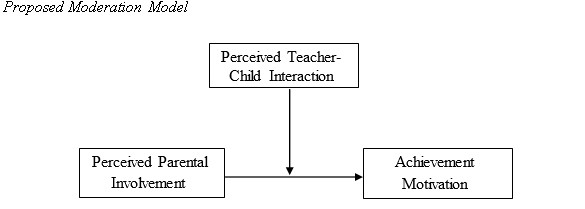
There were several studies which conducted on perceived parental involvement, perceived teacher-child interaction and achievement motivation of school children. Such as Regner et al. (2009) described the relationships among student‘s perception of parental and teacher involvement with achievement goals. Nunez, et al., (2019) studied the relationships between perception of students about teacher and parental involvement in homework assignments. Further, they also observed the motivation as the moderator between teacher and parent‘s involvement in home assignments with the student‘s engagement in work. Student‘s perception level of parental involvement was also examined as the predictor of academic motivation (Boonk et al., 2020). Havik and Westergard (2019) examined the relationships between student‘s perceptions of teacher classroom interaction and the student‘s behavioral and emotional attitude toward study. Further, the impact of the teacher-child interaction on the motivation and achievement level of the students was also observed in different empirical studies (Akhtar et al., 2019).
The findings of the study will increase the level of awareness among parents of adolescents about the significance of parental involvement in their children‘ academic performance. Such studies guide the parents if they want to have batter academic performance of their children. Similarly, findings of the study help teacher to understand the impact of their interaction patterns on students‘ achievement. Every teacher wants that his/her students show good results which is ultimately the depiction of his/her good teaching methodologies and expertise. So, teachers can improve their interaction with their students in order to have outstanding output from students.
Objectives of the Study
The objectives of the study were to:
- Examine the relationships among perceived parental involvement, perceived teacher- child interaction and achievement motivation in school children of Gujrat city
- Evaluate the perceived teacher-child interaction as a moderator between perceived parental involvement and achievement motivation among school children
- Find the differences in perceived parental involvement, perceived teacher-child interaction and achievement motivation of school children in relation to their demographic characteristics
- Perceived parental involvement and perceived teacher-child interaction will be significant predictors of achievement motivation among school children.
Method
Research DesignCross sectional research design was used in the present study.
Sample
Target population of current study was children of 9th and 10th classes, enrolled in English medium sections of government and private schools of Gujrat, Pakistan. Using Multistage stratified sampling technique, the sample of 328 students (government and private schools) were drawn from total 1,831 target population by applying taro Yamane formula. At first stage, target population was divided into two strata of private and government schools of city Gujrat. At second stage, each stratum of private and government was divided into two strata of 9th and 10th class. At third stage, each stratum of class was further divided into strata based on student‘s gender (see flowchart).
Figure 2 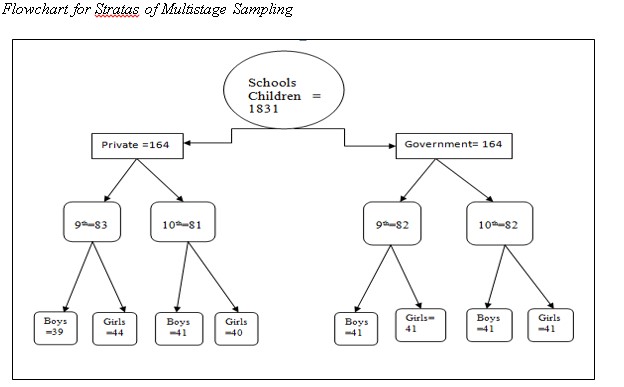
Flowchart for Stratas of Multistage Sampling
Following the equal allocation technique, students were selected from each stratum at three stages.
Assessment MeasuresResearch instrument was consisted of following measurements:
Demographic Information SheetDemographic variables of respondent‘s school, class, gender, grades in last class, age, family system, residential area, and homework support service were included in demographic sheet.
Home Environment Scale ([HES]; Muthee, 2009)Perceived parental involvement was measured by using the Home Environment Scale (HES: Muthee, 2009). It was consisted of 30 items with the response pattern of 3-point Likert scale ranging from: Always (A) = 3, Sometimes (S) = 2 and Not at all (N) =1. The reliability of the scale was .715 (Muthee, & Thomas, 2009). For current study, its reliability was 0.95.
Questionnaire on Teacher Interaction- Student Version ([QTI]; Wubbles & Levy, 1992)Questionnaire on Teacher Interaction was used to asses perceived teacher-child interaction (QTI: Wubbles & Levy, 1992). Student version of secondary school children of QTI, consisted of 48 items with response pattern of 5- point Likert scale from 0 to 4, 0 represents Never and 4 was indication of Always. Reliability for different scales of QTI ranges from 0.60 to 0.96 (Fisher & Rickards, 1998). In current study its reliability was 0.99.
Motivation Inventory ([AMI]; Muthee & Thomas, 2009)Achievement Motivation Inventory (AMI: Muthee & Thomas, 2009) was used to measure children‘s academic achievement motivation. It was comprised of 32 statements with response pattern of 5- point Likert scale ranges from: Completely Agree (C.A.) =5, Mostly Agree (M.A.) = 4, Agree to some extent (A.S.E.) =3, Mostly Disagree (M.D.) = 2 and Completely Disagree (C.D.) =1. The reliability of scale was 0.749 (Muthee, & Thomas, 2009). In current study, the reliability of scale was 0.97.
ProcedureAfter following ethical considerations, data were collected through questionnaires from respondents in group sessions (15-20 students in each group). On average, it took 25-30 minutes to complete the questionnaires. Descriptive and inferential statistics were used to analyze the data by using SPSS (21 version) and process Hayes (3.4 version).
Ethical ConsiderationsPermission was taken from the research institutional review board of university of Gujrat to conduct the cross-sectional study. Permissions to use the scales and to collect the data were also taken from the authors through an email and school‘s heads through permission letter respectively. Significance of research and required information regarding the objectives of the study was provided to participants. Written consent to participate in the research was taken from participants. Further, they were also informed that they had right to withdraw anytime from research.
Results
The demographic characteristics revealed that maximum respondents fall in age group of 13 to 17 years with mean age of 14 years. Gender ratio of participants was almost same and the numbers of students studying in 9th and 10th classes were 165 and 163 respectively. The ratio of government and private school students was also equal (164.) Most of the respondents had nuclear family system (f= 188 with 57.3%) and respondents who came from urban areas (f = 200 with 61%) were greater in number as compared to those respondents who came from rural areas (f = 128 with 39%). There were 127 students who attended private tuition (f= 127 with 38.7%) as compared to majority of students who did not attend private tuition and studied at home by their parents (f = 99 with 30.2%) or by self-study (f = 66 with 20.1%).
Figure 3 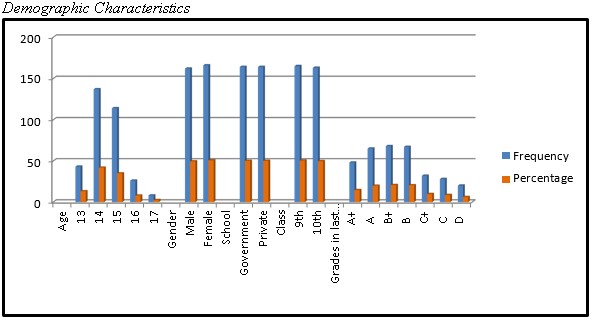
Figure 4
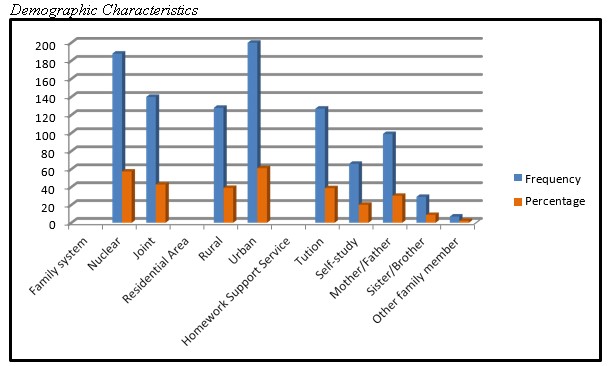
Correlation analysis was run to examine the relationships among perceived parental involvement, teacher-child interaction and achievement motivation. Results indicated that perceived parental involvement, perceived teacher-child interaction and achievement motivation were strongly positively correlated (p < .01) with each other. Further, it depicted that achievement motivation increased as perceived parental involvement and perceived teacher-child interaction increased among government and private school children of 9th and 10th class.
Table 1 
Further moderation analysis was also run to find the moderating role of perceived teacher-child interaction between perceived parental involvement and achievement motivation. The results depicted the significant model (F (3, 324) = 1914.55, p≤.001) with 97% variance. The perceived parental involvement and perceived teacher-child interaction were also significantly positively predicted the achievement motivation (p≤.001), which showed that the high perceived parental involvement and high perceived teacher-child interaction lead to high achievement motivation among school children. The interaction of the perceived parental involvement and perceived teacher-child interaction also significantly positively predicted the achievement motivation (p≤.05) with .09 % variance, which presenting that children achievement motivation affected by their perception of parental involvement and teacher-child interaction. Furthermore, the lower, moderate and high values of B also presented that the interaction of the perception related to parents and teacher involvement positively predicted the achievement motivation among both type (government and private) of school‘s children.
Table 2 
The slope for the interaction of the perceived parental involvement and perceived teacher-child interaction at lower, moderate and higher level indicating the higher achievement motivation in response to higher perceived parental involvement and higher perceived teacher-child interaction.
Figure 5 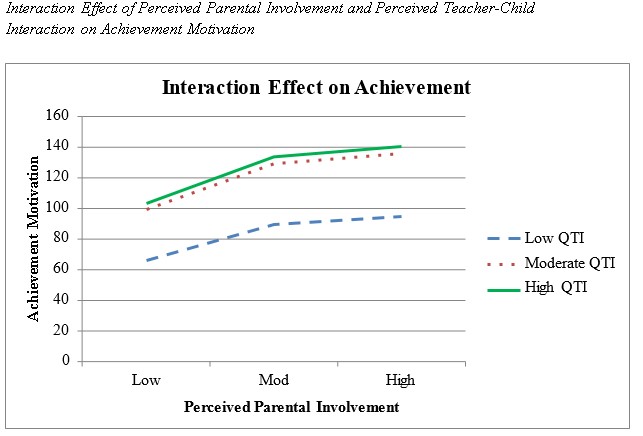
The Independent sample t-test revealed that female students had higher perceived parental involvement (M=73.1, SD= 10.6) as compared to male students (M=62.1, SD=16.4, t (328) = -7.18, p < .001). It further depicted that female respondents had high level of perceived teacher-child interaction (M= 154.1, SD= 36.8) as compared to male respondents (M= 108, SD= 68.2, t (328) = -7.62, p < .001). Similarly, values given in table showed that girls scored higher in achievement motivation (M= 126.1, SD=21.6) than boys (M= 103.6, SD=35.4, t (328) = -6.97, p < .001).
Table 3 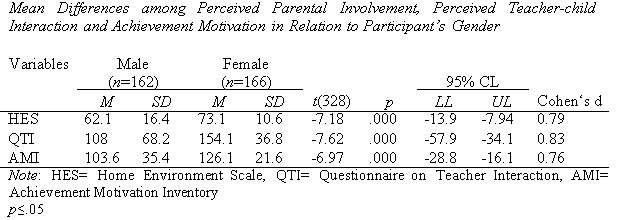
Note: HES= Home Environment Scale, QTI= Questionnaire on Teacher Interaction, AMI= Achievement Motivation Inventory p≤.05
Furthermore, t-test was also applied to see the difference in perceived parental involvement, perceived teacher-child interaction and achievement motivation in relation to school type (government and private). Results indicated that students studying in private schools had greater perceived parental involvement (M=75.9, SD= 5.39) as compared to students studying in government schools (M=59.5, SD= 16.5, t (328) = -12.09, p < .001). Similarly, students enrolled in private schools perceived their teachers in a more positive way (M= 163.3, SD= 17.1) as compared to students who were enrolled in government schools (M= 99.3, SD= 68.4, t (328) = -11.6, p < .001). Table also demonstrated that students getting education in private schools had higher achievement motivation (M=131.3, SD=11.8) as compared to students studying in government schools (M=98.7, SD= 35.9, t (328) = -11.03, p < .001).
Table 4 
Discussion
Study was conducted with the aim to examine the moderating role of perceived teacher child-interaction between perceived parental involvement and achievement motivation among school children of 9th and 10th class. The first objective of the study was to examine the relationship among perceived parental involvement, perceived teacher-child interaction and achievement motivation among school children of Gujrat city. The results indicated that perceived parental involvement and achievement motivation are statistically significantly positively correlated (r= .95). Findings are consistent with the results of previous studies (Acharya & Joshi, 2011; Gonzalez-DeHass et al., 2005; Shukla et al., 2015). They found that a prominent positive correlation exists between perceived parental involvement and achievement motivation of students. It also demonstrated strong significant positive correlation (r= .96) between perceived teacher –child interaction and achievement motivation of students. Findings are also in line with the study of Nugent, 2009 who concluded that a significant positive correlation exists between perceived parental involvement and achievement motivation of students. Further, it is also stated that a healthy relationship between students and teachers is necessary for the success of students. Moreover, the positive relationship between perceived parental involvement and perceived teacher-child interaction was also examined in current study. Nunez, et al., (2019) also supported the findings of current study who described the relationship between perceived parental involvement and perceived teacher-child interaction.
First hypothesis of the current study stated that perceived parental involvement and perceived teacher-child interaction will be the significant predictors of achievement motivation among school children. The results showed that perceived parental involvement and perceived teacher-child interaction significantly predicted the achievement motivation and the value of R²= .94 indicated that regression model of perceived parental involvement and perceived teacher-child interaction accounted 94% variation in achievement motivation. Present finding is consisted with different studies which demonstrated that perceived parental involvement and perceived teacher-child interaction were the significant predictors of achievement motivation among school children (Anozie & Anozie, 2017; Eskeles et al., 1994; Opdenakker et al., 2011).
The second objective of the present study was to examine the perceived teacher-child interaction as moderator between perceived parental involvement and achievement motivation among children of government and private schools. The results demonstrated the significant moderator between the perceived parental involvement and achievement motivation. Up to researcher‘s knowledge, there were no research which exactly studied the perceived teacher-child interaction as moderator between perceived parental involvement and achievement motivation. But Huber et al., (2012) observed the teacher support as moderator between life stressful events and the behaviors of the children. It means teachers‘ supportive behaviors are important for students in order to empower them in dealing with their life stresses as well as for improving their behavioral efficacy.
The third and last objective of the current study was to differentiate the perceived parental involvement, perceived teacher-child interaction and achievement motivation in relation to children‘s gender (male or female) and school‘s type (government and private). The results explained that significant differences exist in perceived parental involvement, perceived teacher-child interaction and achievement motivation with regard to participant‘s gender. Results of current study showed that female students scored high on all these three constructs. Table 3 presented that girls perceived greater parental involvement (M= 73.1) as compared to boys (M= 62.1). Probably, cultural perspective is playing a role in the findings as female students generally spend most of their time at home with their parents after school so, apparently, they seem closer to their parents as compared to boys who also spend their time outside the home with their social groups after school. Present findings are also consistent with the findings of Hashmi et al. (2014); Marshall et al. (2014); Acharya and Joshi (2011), and Ratelle et al. (2005). These studies illustrated that girls score higher than boys on perceived parental involvement. It also represented that female students perceived higher level of teacher-child interaction (M= 154.1) as compared to male students (M= 108). The result was in line with Brok et al. (1998) and Rickards (1998) who argued in their studies that female perceived their teachers in a positive way and consider them more cooperative and dominant than male students. Similarly, results depicted that girls are highly motivated (M= 126.1) as compared to boys (M= 103.6). Findings are supported by previous studies (Maheswari & Aruna, 2016; Kumar & Yadav, 2015; Wani & Masih, 2015; Badola, 2013 and Shekhar & Devi, 2012) which also reported significant differences in achievement motivation of students in relation to their gender. Further, it is also reported in the findings that girls have higher level of achievement motivation as compared to boys.
Findings indicated that private school students scored higher in perceived parental involvement, teacher-child interaction and achievement motivation as compared to government school students. Table 4 indicated that students enrolled in private schools perceived higher parental involvement (M= 75.9) than those who were enrolled in government schools (M= 59.5). Present finding was in contrast with Hashmi et al., 2014 who reported no significant differences in parental encouragement between private and public- school children. Outcomes of current study indicated that students getting education in private schools, perceived teacher-child interaction in more positive way (M= 163.3) than students of government schools (M= 99.3) and up to researcher‘s knowledge, there is no study which focused these constructs. Probably, teachers of private schools seem lenient, cooperative, motivated, polite and friendly because of instructions from administration who wants to restore the maximum strength in school. So, a healthy teacher-student relationship develops among teachers and students while on the other hand government schools‘ teachers have generally regular job status which make them more independent in their teaching patterns. Sometimes they become stricter and give hard time to students. In this way, students may not develop a healthy perception of their relations with the teachers. Similarly, it was also identified that students enrolled in private schools were highly motivated (M= 131.3) as compared to students studying in government schools (M= 98.7). Present finding supported the findings of some previous researches (Badola, 2013; Bharanbe, 2016; Kumar and Yadav, 2015 which also reported the same findings by highlighting the higher motivation of students from private schools as compared to government schools.
The current study has some implications for educational settings. Parents should focus on providing a healthy environment to their children along with their involvement in academic processes so, children can show maximum progress by using their maximum potential. It is important for parents to be familiar with their role in education of their children. By using the findings of the current study, teachers and school administration can improve their efficacy in form of students‘ performance in academics by adding the healthy interaction patterns. Teachers and counselors can work on students‘ motivation in order to improve their responsible behaviors. Teachers need to develop a healthy relationship with their students adopting polite, cooperative, helping and effective teaching methodologies because teacher-child interaction effects greatly the achievement motivation of students. There is an immense need to conduct motivational seminars or counseling sessions about triangular role of parents, teachers and students in academic success of students. In order to gain advancement and better results, government need to emit the gap between government and private school systems at policy level. Proper guidance and counseling should provide to school children at different levels of their educational progress so, that they feel motivated for achievement of goals.
Conclusion
Relationship among perceived parental involvement, perceived teacher-child interaction and achievement motivation of school children had been found in different studies. It highlighted the fact that when parents engage themselves in academic activities of their children it raises the morale of children and they ultimately strive for better achievement. Similarly, when teachers cooperate with students and show a polite and supportive attitude towards students ultimately their fear reduces and they can fully concentrate on their studies with high achievement motivation.
Implications and Limitations of Study
Research was conducted only in one city of Pakistan so, generalization of results to entire secondary school students at district or national level may be limited. Present study was a cross sectional study, data were collected at one point of time rather than on longitudinal basis so it is not possible to determine the progressive changes in student‘s perception of parental involvement, teacher-child interaction and their achievement motivation in term of identifying relatively a persistent pattern.
Future researches should study the teaching strategies and interaction patterns of school teachers in order to find the causes of lack of poor teacher-child interaction and achievement motivation among school students. Only the students who were enrolled in English medium sections were taken as participants, students of Urdu medium sections should be the part of future researches. In present study, respondents were taken from secondary schools of government and private sectors, future studies may endeavor to expand this area of research at primary and middle levels in schools as well as in colleges and universities. Qualitative research design can be adopted in future researches in order to have the clearer version of parents, teachers and students in this regard.
References
Acharya, N., & Joshi, S. (2011). Achievement motivation and parental support to adolescents. Journal of Indian Academy of Applied Psychology, 37(1), 132-139.
Acharya, N., & Joshi, S. (2009). Influence of parent‘s education on achievement motivation of adolescents. Indian Journal Social Science Researches, 6(1), 72-79.
Akhtar, S., Hussain, M., Afzal, M., & Gilani, A. S. (2019). The Impact of Teacher-Student Interaction on Student Motivation and Achievement. European Academic Research, 7(2), 1201-1222.
Anozie, E., & Anozie, O. (2018). Parent-Child and Teacher-Pupil Relationships as Predictors of Academic Motivation and Achievement among Primary School Pupils. Journal of Psychology and Sociological Studies, 1(1), 62-79. https://www.journals.aphriapub com/index.php/JPSS/article/view/52.
Badola, S. (2013). Effect of School‘s on academic achievement motivation of secondary level students. Educationia Confab, 2(5), 61-66.
Bharanbe, K. D. (2016). Achievement motivation: a comparative study of private and government school students. The International Journal of Indian Psychology, 3(2), 46-50. http://oaji.net/articles/2016/1170-1455817897.pdf.
Boonk, L. M., Gijselaers, H. J. M., Ritzen, H., & Brand-Gruwel, S. (2020). Student-perceived parental involvement as a predictor for academic motivation in vocational education and training (VET). Journal of Vocational Education and Training, 1-23. https://doi.org/10.1080/13636820.2020.1745260.
Emerson, L., Fear, J., Fox, S., & Sanders, E. (2012). Parental engagement in learning and schooling Lessons from research. A report by Australian Research Alliance for Children and Youth (ARACY)for the family-school and community partnerships Bureau: Canberra. Family-School and Community Partnerships Bureau.
Eskeles, G. A., James, F. S., & Allen, G, W. (1994). Role of parental motivational practices in children's academic intrinsic motivation and achievement. Journal of Educational Psychology, 86(1), 104-113. http://dx.doi.org/10.1037/0022-0663.86.1.104.
Fisher, D., & Rickards, T. (1998). Associations between teacher-student interpersonal behaviour and student attitude to mathematics. Mathematics Education Research Journal, 10, 3–15. https://doi.org/10.1007/BF03217119.
Fredriksen, K., & Rhodes, J. (2004). The role of teacher relationships in the lives of students. New Directions for Youth Development, 103, 45-54. https://doi.org/10.1002/yd.90
Gonzalez-DeHass, A. R., Willems, P. P., & Doan Holbein, M. F. (2005). Examining the relationship between parental involvement and student motivation. Educational Psychology Review, 17(2), 99-123. https://doi.org/0.1007/s10648-005-3949-7.